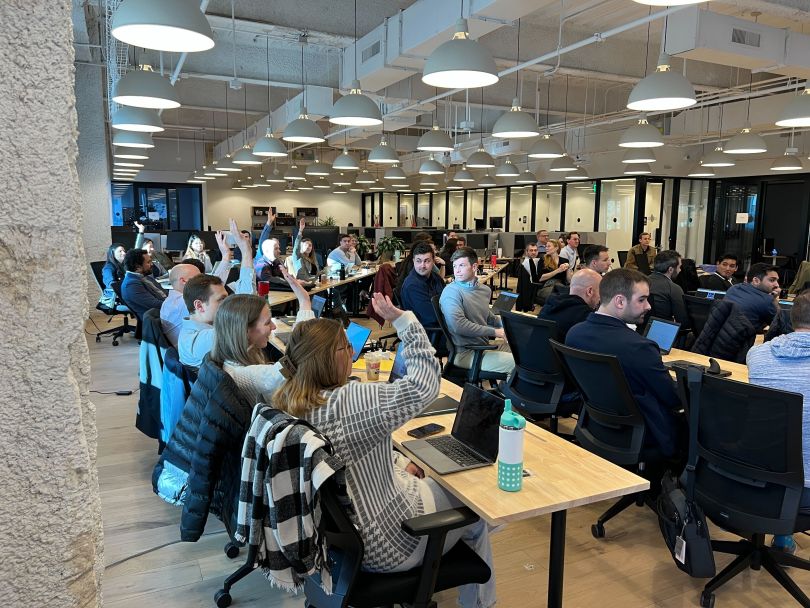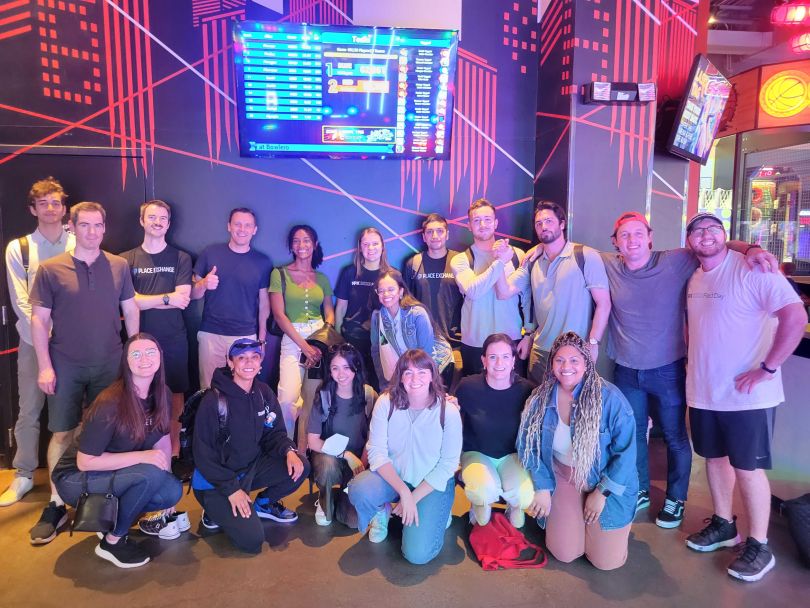“What keeps you up at night?”
This question has become so common in conversations between customer success managers and their clients that it is now cliché, according to Riskified Director of Account Management Karl Weiss.
“‘What keeps you up at night?’ doesn’t get you very far,” he explained. “‘I’m hearing XYZ from businesses similar to yours. How are you handling that challenge?’ will steer the conversation towards an area where you can advise.”
CSMs are in a unique role that balances their own company’s needs (i.e., revenue and client retention) with those of their client. Focus too much on the revenue, and the client doesn’t value the relationship. Focus too much on the client, and the revenue remains stagnant. Find the right balance between the two, and the CSM has mastered the art of the consultation — now, the customer sees them as a valued advisor.
Built In NYC sat down with six successful CSMs from local companies to uncover their approach, key skills they prioritize and the on-the-job training that keeps them at the top of their game.
Spring Health uses clinically validated AI tech, called Precision Mental Healthcare, to deliver optimal care to members, partnering with both employers and health insurers across the globe to make mental health accessible and achievable.
What steps do you take to better understand the needs, goals and expectations of your customers?
It is important to be proactive and ask the right people the right questions to understand what your customer’s workforce actually needs.
At the executive level, they care about the overall fit and competitiveness of their benefits suite being offered, so we need to be asking questions about what types of benefits they’re offering broadly and help them identify where the gaps are.
Do they need to have a bigger global presence? Are they ramping up new departments that need different types of benefits? Is there a standard for benefits in their industry that isn’t currently being met?
Often, looking at companies in the same industry can help identify what a best-in-class benefits suite looks like. Then, we can use that as a reference point to make sure we are meeting the needs of this type of customer.
That executive-level conversation is going to be very different from conversations with an HR business partner that mainly is employee facing. They care about the benefit’s ease of use, how seamless communication can be and what the end user is experiencing. We want our solution to work so well that it makes their lives easier.
What training is in place to help CSMs in your organization become experts on your products and industry? What impact has that had on the relationships CSMs have with their clients?
Here at Spring Health, we frequently collaborate with world-class clinicians and experts that have the highest level of training and certifications.
They offer us folks on the customer-facing side of the organization information on geographical trends (how depression, anxiety and other conditions may be changing in the populations we serve), mental-health focused certifications of our own like Mental Health First Aid, and they help us get our arms around clinically validated measurement tools like the PHQ-9 and GAD-7 to understand how our members are actually using Spring Health against what's available in the open market.
When we bring these kinds of insights and facts to our customers, it helps us be their true partner in mental health and wellbeing benefits because we can talk about Spring Health in a broad lens that captures the incidence and impact of mental healthcare to their organization in the context of the world around us. Essentially, it keeps us thinking big, breaks down echo chambers and ensures we have all of the best information at hand to help our customers make all of the best decisions for their workforce.
We capture the incidence and impact of mental healthcare to our partners’ organizations in the context of the world around us.”
What soft skills have you found to be particularly important when it comes to consulting your clients? How have you strengthened those skills over time?
One of the best soft skills is emotional intelligence — our clients are people, too. When the HR business partner overseeing your product at ABC Company is suddenly busy as a bee and white-knuckling their keyboard, you have to notice that and respond to that by seeing how you can make their job easier. That might mean changing who owns some tasks in a marketing project plan or changing the timeline for a conversation you want to have about a new product coming out.
One of the best ways I have improved my emotional intelligence is actually by working on another soft skill called active listening. Active listening means you’re focused with as many senses as possible on the speaker, trying your best to actually absorb what you’re hearing instead of mentally drafting your response the entire time the other person is talking.
These simple skills dramatically change the time you spend with your customers. It makes your meetings more ‘real’ and rewarding. Role playing is a great catalyst for improving these skills. Also, if you have any meetings recorded, watch them back and, even if you hate the sound of your own voice, you will learn so much. And your customers will thank you for it!

Celonis’ process-mining technology helps rapidly enhance process performance for business executives worldwide.
What steps do you take to better understand the needs, goals and expectations of your customers?
The first step to best understand customer goals and expectations is to build our core focus team. I focus on ensuring that we engage relevant stakeholders from both business and IT in our requirements-gathering sessions. A comprehensive, core focus team helps us understand multiple perspectives about ongoing issues, limitations and areas needing improvement.
In conversations with this core focus team, it is important to let the customer inform the team of the issues, and then leverage past experience to help begin solution development — let the customer express the depth and breadth of their current problem areas before prematurely assigning a path forward. Without a holistic understanding — through engaging multiple perspectives from the customer — we risk solving only part of the problem.
Let the customer express the depth and breadth of their current problem areas before prematurely assigning a path forward. Without a holistic understanding, we risk solving only part of the problem.”
Finally, I send a recap email documenting exactly what was covered in the sessions, along with tangible next steps. Radical transparency will always be welcomed by the customer, so establish this early and often in the delivery cycle.
What training is in place to help CSMs in your organization become experts on your products and industry? What impact has that had on the relationships CSMs have with their clients?
We have our very own Celonis Academy — a great tool to leverage for an introduction to and baseline understanding of our product. The information we gain from the academy training enables us to have informed conversations around areas of interest for the customers. It also allows us to plug any knowledge gaps we have, keep up with our new product updates, and become true Celonis experts.
Complementing our academy is our fantastic enablement team. The team spends a lot of time and effort coordinating with Celonauts for proof points across different industries to make sure we’re prepared for any and every challenge. Their efforts allow for tangible knowledge transfer and pro tips that will further our understanding of solutions, limitations and requirements for success. Coming to the customer with past experience will instill confidence that extends the discussions past ‘the art of the possible’ into ‘the art of reality.’
What soft skills have you found to be particularly important when it comes to consulting your clients? How have you strengthened those skills over time?
Communication is key. Ensuring that your customer is always ‘in the know’ is important — this is accomplished through purposeful meetings and consistent alignment on desired outcomes. It also needs to drive understanding for the customer. Celonis can be complex, so we break down complex problems and solutions into digestible chunks — either through phases or sequential action lists to show our path to solution.
Time management is a constant struggle for all consultants, so do not feel alone here. I’ve learned that consistent alignment with the customer helps mitigate the risks time management issues can cause. Ensure that the customer is aligned with what the team is putting efforts toward each week, and what that means for other work streams and initiatives.
And finally, leadership. Customer confidence is key in our success. We are the product experts, so if we’re presented with a question that we do not have the answer to, it is perfectly acceptable to communicate this lack of exposure and ask internally to get a resolution. This shows the customer our leadership and expresses our shared interest in getting them the right answer — not the convenient answer.
Contentsquare is a digital marketing experience analytics company on a mission to make the digital world more human.
What steps do you take to better understand the needs, goals and expectations of your customers?
It is crucial to follow a ‘step-by-step’ approach. Being disciplined saves time and energy and maximizes the chance of success for all stakeholders.
First, the handover with sales should be detailed and transparent about official and unofficial promises accompanying contractual terms. This includes top business challenges, reasons for purchase, expectations, budget owners, main decision makers, success criteria and use cases shared during the pre-sales process.
Second, the kickoff is a face-to-face meeting with the budget owner and/or decision makers, confirming the details from the handover with sales. It involves sharing the first draft of a success plan with key business objectives and key stakeholders, along with research on overall business activity, recent public news and background information on those involved.
Third, the operational kickoff comprises an ‘onboarding agreement’ to set enablement strategy and schedule. Roles and responsibilities are defined, and the strategic plan is translated into operational tactics, measurements, ownership and timelines.
Lastly, quarterly business reviews are ongoing.
Following this structured and disciplined process enhances the likelihood of success.
What training is in place to help CSMs in your organization become experts on your products and industry? What impact has that had on the relationships CSMs have with their clients?
Internally, in addition to our comprehensive onboarding program, we hold monthly product release events for CSMs, enabling them to deliver value through new features. Solution experts are dedicated to enabling users on Contentsquare, focusing on use cases and assisting CSMs. We’ve introduced specialized positions for CSMs and solutions experts to cater to different industry needs and expand expertise. This verticalization aligns with our business share size and allows us to focus on specific verticals like business-to-business companies and the financial services industry, enhancing our capabilities. Our commitment to customer-centricity drives these strategies for exceptional service and success.
What soft skills have you found to be particularly important when it comes to consulting your clients? How have you strengthened those skills over time?
Being value-oriented is paramount, shaping all actions in line with decision makers’ preferences. This should always be kept in mind.
Being value-oriented is paramount, shaping all actions in line with decision makers’ preferences.”
Intimacy with stakeholders is also crucial. Stay close to decision makers and influencers, fostering relationships through personal interactions like breakfast, lunch, QBR meetings and marketing events, preferably in person. Always seek to meet new departments within clients’ organizations.
Strengthening internal relationships enhances issue resolution, team coordination and communication.
Assertiveness with a diplomatic yet result-oriented approach — and a willingness to escalate when needed — ensures progress.
Anticipation, prioritization and execution are the guiding principles for our success in strengthening these skills.
Yotpo is an e-commerce marketing platform that integrates data-driven solutions for reviews, loyalty, SMS marketing and more, accelerating direct-to-consumer growth for thousands of brands.
What steps do you take to better understand the needs, goals and expectations of your customers?
I always ask for customer feedback at the beginning of calls to determine what they want to start, stop and continue. A specific question that I ask is, “What does success look like for your brand?” This question will usually get them to open up and let you know what their goals are.
I always ask for customer feedback at the beginning of calls to determine what they want to start, stop and continue.”
What training is in place to help CSMs in your organization become experts on your products and industry? What impact has that had on the relationships CSMs have with their clients?
We have weekly meetings with the learning and enablement team to get trained on a specific topic or product feature, as well as other one-off team trainings about competitors in the space that help us become better CSMs.
This has a huge impact on our client relationships, as it enables us to confidently discuss the topics that mean the most to them and bring them the most success.
What soft skills have you found to be particularly important when it comes to consulting your clients? How have you strengthened those skills over time?
Communication, interpersonal skills and attention to detail are very important soft skills to have as a CSM when it comes to consulting clients. Communication to make sure you are clear in the message you are trying to deliver, interpersonal skills so your client gets that human element and attention to detail so nothing gets missed. I have strengthened these skills over time by making sure I focus on them in every single interaction and learning from my mistakes.

Riskified’s machine-learning platform provides frictionless fraud management for e-commerce companies.
What steps do you take to better understand the needs, goals and expectations of your customers?
First, do your homework: Who is the customer, what is their business model, what recent events have happened, and why they are working with your business? It will go a long way in building trust.
Second, ask pointed-yet-broad questions. Focus on topics where you know you can support them. “What keeps you up at night?” doesn’t get you very far. “I’m hearing XYZ from businesses similar to yours. How are you handling that challenge?” will steer the conversation towards an area where you can advise.
Third, add value. Rather than talking about a solution, talk about trends, insights and things you’re seeing and hearing with customers. Use these conversations to get insight into the merchant’s challenges, allowing you to prepare for the next interaction in a more strategic way.
And lastly, be timely. It should go without saying, but if you say you’re going to do something, do it. Keep your contact engaged and deliver on what you’ve promised. You’ll be surprised how quickly your customer will start looking to you for advice and guidance on challenges they are facing.
What training is in place to help CSMs in your organization become experts on your products and industry? What impact has that had on the relationships CSMs have with their clients?
We have a very robust e-learning and document-sharing platform that enables the baseline industry and product learnings. The most impactful training in my opinion are the deal and call reviews. Listening to yourself and your peers on calls and in meetings is invaluable in gauging how you are doing in understanding the needs, goals and expectations of your customers. It also helps to learn how others' decisions differ from yours. Be open to suggestions and constantly be working on your own craft by observing others.
Listening to yourself and your peers on calls and in meetings is invaluable.”
What soft skills have you found to be particularly important when it comes to consulting your clients? How have you strengthened those skills over time?
Empathy — put yourself in their shoes. Seeing your customer’s point of view enables you to address the challenges as they see them and, in turn, move into an advisor position.
Listening — make sure you are giving your customer the opportunity to speak, react and explain themselves. This allows you to better understand their point of view and problem.
Clear and concise communication — more often than not, you are the expert on a particular topic and know every detail. But don’t let your vast knowledge on the subject confuse your customer. Use analogies, give context and break it into pieces. It may seem obvious to you, but it isn’t always that way for your customer.

Place Exchange is a programmatic platform for out-of-home and place-based media, using technology to connect digital marketers to consumers in a physical space.
What steps do you take to better understand the needs, goals and expectations of your customers?
In our organization, there is a high amount of quickly needed, deadline-based work requested of us by our customers. When our customers ask us for something, we’re always in the mindset of interrogating each and every ask. This is in an effort to provide our customers with the most robust, well-rounded response possible the first time around, and build upon our knowledge of their needs in general.
With every request, part of our discovery involves their expectations of us for the request at hand, to ensure we exceed them accordingly. Over time, we’re able to observe and record patterns that allow us to address the needs of each customer uniquely within our team processes. Additionally, we strive to make recommendations that go beyond the scope of the ask at hand, to ensure we’re putting our best foot forward for every opportunity and are continuing to educate our customers on our offerings.
We strive to make recommendations that go beyond the scope of the ask at hand, to ensure we are continuing to educate our customers on our offerings.”
At a higher level, we work on discovery on an ongoing basis, ensuring we are keeping up to date with the latest information as it pertains to our customers.
What training is in place to help CSMs in your organization become experts on your products and industry? What impact has that had on the relationships CSMs have with their clients?
For all new CSM team members at Place Exchange, we have robust documentation and an onboarding plan in place that involves in-depth training on each function of the job, culminating in the assignment of a book of business. Beyond learning the functions of the job, new team members meet with every department head in the company to learn more about what their teams work on and how they interact with the CSM team.
Additionally, PX regularly offers cross-functional courses for both new hires and existing team members. In these sessions, a PX team member will teach a course about a topic specific to Place Exchange and its applications to the programmatic out-of-home industry — and our clients — in general. Outside of that, PX has many partners who offer free courses on special topics, in addition to course offerings from industry organizations such as the Out Of Home Advertising Association of America and DPAA.
The continual knowledge sharing across internal teams, external partners and industry organizations allows CSM team members to stay sharp and current on their knowledge of new PX and industry offerings, further cementing their status as a trusted source with their clients.
What soft skills have you found to be particularly important when it comes to consulting your clients? How have you strengthened those skills over time?
Attention to detail stands out to me as the most important soft skill for a CSM team member at PX. This skill involves noticing and recording details — big and small — about our clients, and considering these observations in every interaction with them, allowing us to anticipate their needs and proactively address potential issues before they arise.
Communication, both written and verbal, and organization are two additional crucial skills in our organization, and I’d argue in any CSM organization. Communication involves responsiveness, accessibility over email and phone, and presenting information in the most digestible and relevant way to our clients. Organization involves tracking not only day-to-day requests and shorter-term deliverables, but also longer-term projects, growth plans and strategic initiatives with clients. I’ve been able to sharpen these skills over time by viewing every interaction with a client as an opportunity to exceed their expectations, share knowledge and ultimately expand our relationship with them.















